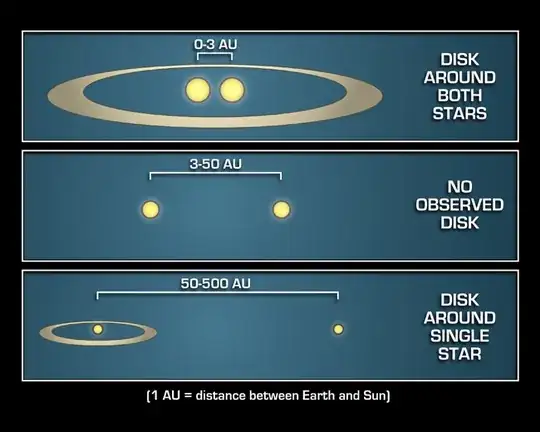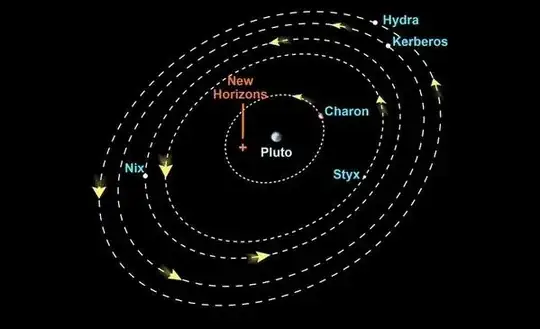Star systems.
There's already a word for this called Hierarchy, described "here". The largest recognized is 4, but that may be unstable. The largest stable one known is 3 hierarchies and when star systems form, they can have 7, 8 or 9 stars, and perhaps more than 4 hierarchies, but those systems tend to be unstable. I think your question only makes sense with stable orbits, so 3 might be the limit just looking at stars, just maybe 4.
Galaxies
Galaxies can orbit other galaxies. 2 Dwarf Galaxies orbit the Milky way.
Does our local group of galaxies orbit a larger group? Does any local group orbit another larger one? There's no evidence that this is the case. Question on that here, and there's limitations on how far galaxy and local group orbits can be extended due to gravity dropping off by the square of the distance and space being so empty and space expanding. I see no logical reason why a galaxy like our Milky way couldn't orbit (instead of crash into) Andromeda, but that's just theoretical. When you get into local groups orbiting something, and not being just an N-body system, but an orbit, that gets more convoluted, and you'd be talking about orbits tens if not hundreds of millions of years in period. As a hunch, I'm going to limit the heircarchy of galaxy orbits to 3. Dwarf galaxy around a spiral galaxy, around a larger galaxy or clump of galaxies. - A limit of 3 is kind of a guess on my part. I also think that's a kind of ugly part of the question. Yes, Galaxies can orbit other galaxies, but it's on such a different time scale.
Stars obviously orbit within a galaxy, but orbits are jostled by other stars, sometimes they even get kicked out or their orbits can measurably change. It's more like orbiting within, not orbiting around.
Planets and Moons.
There's a problem we need to address first and that's the type of star system the planets orbit.
If the 2 stars orbit close to each other, it's very hard to get a planet around one of those stars. (It's possible to have a planet around both), but you only get to count the next orbit once if the planet orbits around both stars.
See diagram

Source.
So, we need "the other kind", not "Circumbinary".
And for "the other kind" to have planets with moons, you need a fair bit of distance between the stars, so heirchy 3 or 4 star systems, we'd need to get a closer look at the outer stars in that system to see if there's room for planets and moons. A close binary, there wouldn't be.

So, there's a natural limitation to this process. When orbiting objects get too close, there's limitations to how many layers of orbits you can go and maintain stability.
Moons have a very hard time having moons. In our solar system there's no known cases of Moons having Moons. There are cases of asteroids orbiting asteroids, but no known cases of asteroids orbiting moons, even though Moons are quite a bit larger on average. Part of this may be that we don't have telescopes good enough to see, but there's also reasons why it's difficult. Three or more body systems tend towards instability and tidal forces would tend to disrupt such systems. Also, the sphere of influence gets quite small for small objects orbiting significantly more massive ones. In addition to small sphere's of influence, perturbations grow with more than one gravitational object in the vicinity. Earth's moon, for example, is perturbed by the sun and it's not gravitationally smooth, so orbits around our Moon are quite unstable long term they are impossible.
For a moon to have a moon, it helps if the planet is quite distant from it's sun and it helps if the Moon is quite distant from it's planet to avoid tidal forces pulling the two objects together. Planet X, for example, could have a moon that has a moon, cause it's so far from the sun, it's almost like a mini solar system. Pluto is quite small but gravitationally it's like a binary system of it's own. Distance helps, but even Pluto-Charon have only 1 hierarchy of moons.

So, there are practical limits of how many orbits around orbits you could build and have them be reasonably long-term stable because you need a significant amount of space and, for the most part, a couple of orders of magnitude between the mass of each object.
If I was to guess, if we say 3 for galaxy orbits, 1 for the system around a galaxy, 3 for stars, and then planet, Moon and moon around the moon, that would be 10 layers of orbits and That would probably be quite rare, as a 3 star hierarchy with enough space to have a planet, moon, moon is a bit of a stretch. That would be my guess as an outside limit.
Now, in practice, if you wanted to build your own orbits in the middle of nowhere, you could go higher than that, but given the nature of galaxies, I think 10 orders of orbit is about as far as it's likely to go and that might even be too high. Might be 9 or maybe even 8.
Since no exo-moon has ever been observed (Exo-Ring systems have), and I'm not sure if any planets have ever been observed on 3 or more heirarchy star systems, I think the observed limit to layers of orbits is quite a bit less than my estimated limit.


